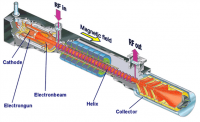








The traveling wave tube is a form of thermionic valve or tube that is still used for high power microwave amplifier designs. The travelling wave tube can be used for wideband RF amplifier designs where even now it performs well against devices using newer technologies. TWTs are used in applications including broadcasting, radar and in satellite transponders. The TWT is still widely used despite the fact that semiconductor technology is advancing all the time.
The traveling wave tube, TWT, has a high bandwidth compared to many other designs and it can operate over bands of up to an octave, although it is possible to utilise narrow band designs when the applications require this. The TWT is essentially a microwave amplifier and TWT amplifiers may be used on frequencies ranging from around 300 MHz up to 40 or 50 GHz and providing gain levels of up to 40 dB in a single device.
TWT amplifiers, TWTAs may consist of two types. Broadband types generally use helix TWT amplifiers and they are typically capable of developing powers of up to 2.5 kW. For narrowband RF amplifier applications it is possible to use coupled cavity TWTs and these can deliver power levels of up to 15 kW.
TWT history and development
The travelling wave tube (traveling wave tube) can trace its origins back to the earliest days of thermionic valve or vacuum tube development. Without the development of these devices the travelling wave tube would not be possible. The tube itself was born out of the need for efficient high power microwave RF amplifiers in the Second World War.
The TWT was actually invented and first developed by an engineer named by Rudolf Kompfner at a government based British radar research laboratory. He developed the basic TWT theory and the practical device. Both the TWT theory and the tube itself were later refined by Kompfner and John Pierce at Bell Labs in the USA.
Traveling wave tube operation
The travelling wave tube, TWT is contained within a glass vacuum tube. This obviously maintains the vacuum that is required for the operation of the TWT.
Within the travelling wave tube the first element is the electron gun comprising primarily of a heated cathode and grids. This produces and then accelerates a beam of electrons that travels along the length of the tube.
In order that the electrons are made to travel as a tight or narrow beam along the length of the travelling wave tube, a magnet and focussing structure is included. The field from the magnet keeps the beam as narrow as required and in this way ensures that the beam travels along the length of the TWT.
The RF input consists of a direction coupler which may either be in the form of a waveguide or an electromagnetic coil. This is positioned near the electron gun emitter and it induces current into the helix.
A helix is an essential part of the traveling wave tube. It acts as a delay line, in which the RF signal travels at near the same speed along the tube as the electron beam. The electromagnetic field due to the current in the helix interacts with the electron beam, causing bunching of the electrons in an effect known as velocity modulation and the electromagnetic field resulting from the beam current then induces more current back into the helix. In this way the current builds up and the signal is therefore amplified.
The RF output from the traveling wave tube consists of a second directional coupler. Again this may either be an electromagnetic coil of a waveguide. This is positioned near the collector and it receives the amplified version of the signal from the far end of the helix from the electron gun or emitter.
An attenuator is included on the helix, usually between the input and output sections of the TWT helix. This is essential to prevent the reflected wave from travelling back to the cathode of the electron gun.
The collector finally collects and absorbs the electron beam. It is in this area that high levels of power may be dissipated and therefore this section of the travelling wave tube can become very hot and will require cooling.
Applications
There are many areas in which TWT amplifiers are used. They are an ideal form of RF amplifier for satellites and as a result they are extensively used for satellite transponders where low levels signals are received and need to be retransmitted at much higher levels. In addition to this TWT amplifiers are used in microwave radar systems where they are able to produce the high levels of power required. Traveling wave tube, TWT technology is also used for electronic warfare applications. In these applications the grid on the travelling wave tube may be used to pulse the transmission.